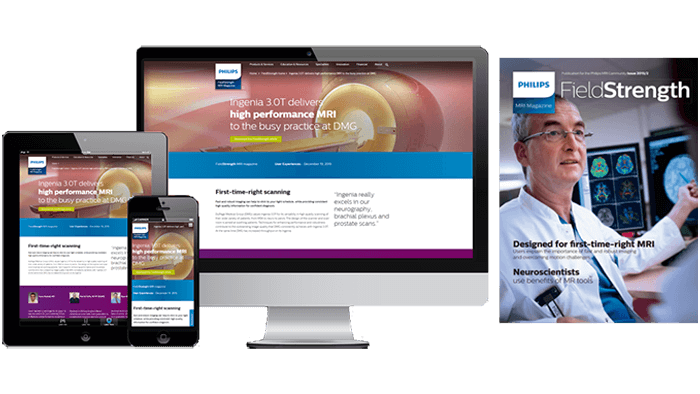FieldStrength MRI magazine
News - September 2016
We offer you a key to confidence when scanning patients with MR Conditional implants
At RSNA 2015 we introduced ScanWise Implant¹. Its dedicated user interface guides you through the few simple steps needed to set up an MRI exam for a patient with an MR Conditional implant.
“This smart technology of the scanner makes it easy for a technologist”
“I feel more confident with ScanWise Implant”
Simplifying scanning of patients with MR Conditional implants
With the ScanWise Implant user interface, you simply enter the value of each MR Conditional parameter as specified by the implant manufacturer. The scanner then automatically adjusts the scan parameters for all scans and pre-scans in the patient’s exam. It’s an easy way to meet the implant’s condition values throughout the whole examination.
When ScanWise Implant guides you, you save 50% of clicks and keystrokes.[2] With ScanWise Implant conditions can be entered in 3 minutes or less. ScanWise Implant is easy to learn and easy to use. It involves no side calculations and no guesswork.
ScanWise Implant enhances user confidence when scanning patients with MR Conditional implants when guided by ScanWise Implant. [3]
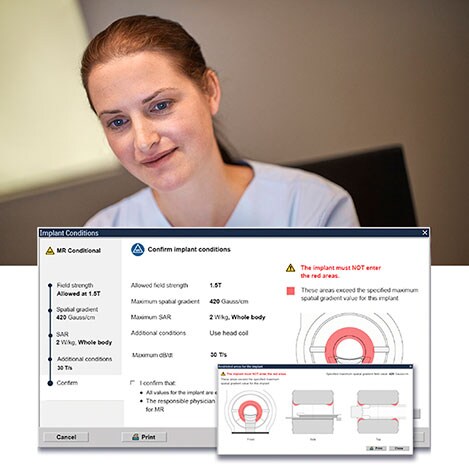
Why would you need ScanWise Implant?
Look at the trends to understand why it’s worthwhile to give it some thought:
> The population of patients with implant is rapidly growing throughout the globe. By 2020 the number of patients with implants in the USA will have grown by 71%. [4]
> The majority of people with an implant are older adults. [4]
> For many medical conditions prevalent among older adults, [5] MRI is a modality of choice.
The simplified scanning workflow offered by ScanWise Implant can help you to serve a growing population of patients with MR Conditional implants. It allows you to increase your referrals.

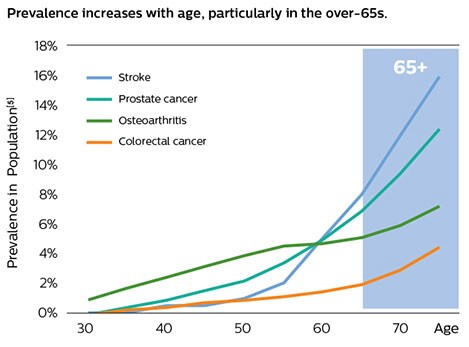
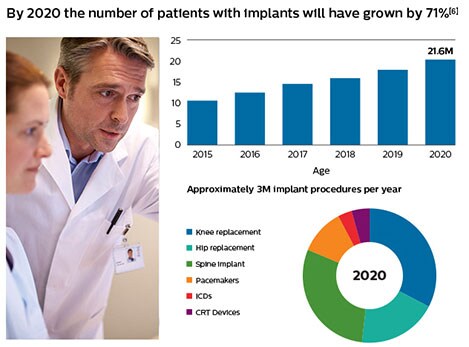
The simplified scanning workflow offered by ScanWise Implant can help you to serve a growing population of patients with MR Conditional implants.
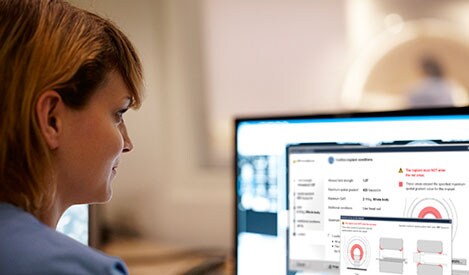
Let ScanWise Implant guide you
ScanWise Implant can be operated with confidence by well-trained radiographers or technologists of all experience levels. Philips ScanWise Implant is available on our 1.5T and 3.0T MRI scanners.
When a patient with MR Conditional implant is referred for MRI
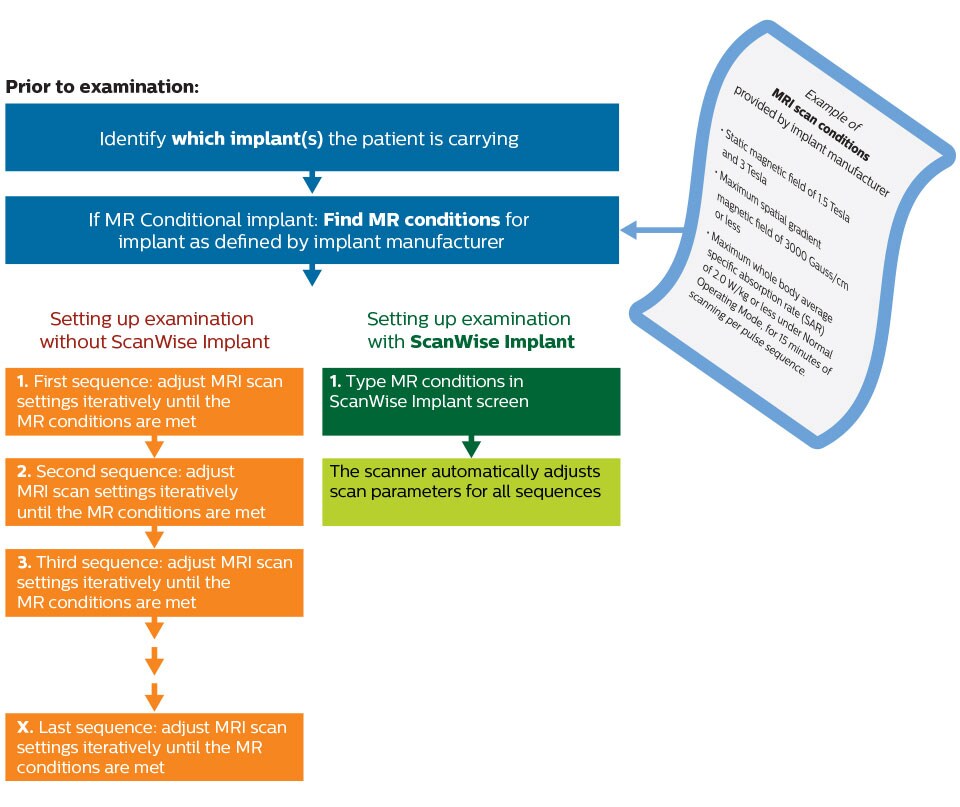
The simplified scanning workflow offered by ScanWise Implant can help you to serve a growing population of patients with MR Conditional implants.
Early user of ScanWise Implant shares experiences
Scott G. Hipko, BSRT(R)(MR)(CT) MRSO, University of Vermont Medical Center, Burlington (Vermont, USA) was one of the first MR technologists to experience ScanWise Implant.
This is what he had to say:
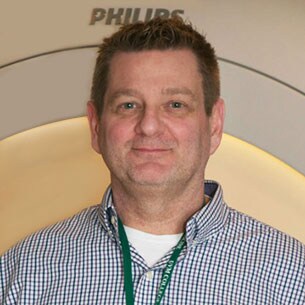
Using the ScanWise Implant smart technology
“Once you know what conditions are associated with the implant of your patient, ScanWise Implant helps speed up the process of parameter setting. This smart technology of the scanner makes it easy for a technologist: after entering the MR conditions as specified by the implant manufacturer only once, the scanner will meet the conditions of the implant throughout the whole examination; rather than the tech trying to bumble around in every sequence to meet the conditions laid out by the MR Conditional implant.”
“Clearly ScanWise Implant can help better meet implant conditions by allowing entering the parameter value as specified by the implant manufacturer only once, and then the system automatically adjusts all scan and pre-scans parameters to meet the implant conditions entered by the user.”
Guiding technologists through a myriad of choices
“Not every tech may know as much as needed for adjusting the scanner to meet the implant’s conditions, so ScanWise Implant helps guide you. Philips is the first MRI vendor to create this.”
“With ScanWise Implant I experience this as a smart scanner. It helps me through this myriad of choices. For instance, when a patient has a deep brain stimulator, ScanWise Implant guides me as it automatically adjusts all scan and pre-scan parameters to meet the implant conditions that I entered.”
“Some patients with active MR Conditional implants used to be denied by the radiology department, although clinicians want us to scan them. Questions that come up are: what are the implications of not doing an exam when you could? What if that one exam changed the outcome of the patient’s disease? If you could have done an exam and said no, what are the costs of saying no when you could have said yes?”
1. Only for use with MR Safe or MR Conditional Implants by strictly following the Instructions For Use. 2. Compared to earlier software release 5.1.7. Data on file. 3. Summative test & customer evaluation, N = 19. Data on file. 4. Data on file based on Millennium Research Group – RPUS21LJ15, RPUS20SP15, RPGL12CR14 and Barmer GEK Arztreport 2011.
5. National Cancer Institute April 2009. US estimated complete prevalence including counts by age on 1/1/2006. Arthritis Rheum. May 1998;41(5):778-799. American Heart Association, Heart Disease and Stroke Statistics – 2010 Update: Learn and Live. Prevalence of stroke by age and sex (NHANES: 2003-2006). 6. MRG-Large Joint reconstructive Implants US_ 2015, MRG Spine US 2015, MRG-Cardiac rhythm management rhythm management device| global | 2014 | Market Analysis.
